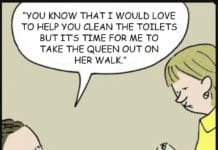I really have no time for graffiti of any kind. I don’t care whether it has been daubed by that anonymous street artist or vandal, depending upon your view of life, going under the name of Banksy, or if it is Juan or Maria who feel the urge to scrawl their names in appalling handwriting on a newly painted wall.
Admittedly, some graffiti can be extremely artistic, amusing, challenging, controversial, but please let us have it on spaces allocated for just that purpose.
Although graffiti is illegal and considered as vandalism in law, some people consider it to be art, because it is a way that people can express themselves and let their voices be heard. Graffiti can be used as artistic expression, or a form of communication and may be best described as drawings or paintings that have been scribbled, scratched or painted, usually illegally, on a wall or other surface, often within public view and is one of the most common and spatial forms of artistic expression.
For many, it is the very act of illegality that is the main attraction. Graffiti writers take over blank (and preferably newly painted) surfaces, which they use as the canvas for new images. Those who study such things consider it to be a ‘sub culture’ and a means of expressing individuality, social and political concerns, as well as some of the most innermost feelings.
In Spain and the Canary Islands, spaces surrounding unsightly areas that are ready for eventual development are often given to specific and proven ‘street artists’ or students as a showcase to demonstrate their artistic skills.
These efforts are often inspiring and a pleasure to look at, but the ‘Maria loves Juan’ statement scrawled across a badly formed heart on a newly painted wall of a nearby shopping centre is little more than vandalism.
Frankly, if that is the best that Juan can come up with to demonstrate his undying affection for his girl, Maria would be well advised to call off the entanglement right away, and look for someone with a few more brain cells and rather more promising artistic ability.
It pleased many locals recently when police in Arrecife, Lanzarote, decided to act against the widespread graffiti across their city.
This new action by police has enabled them to identify 15 local people who have been responsible for causing around 300 acts of graffiti vandalism on public and private property, such as on doors, windows, walls, public benches, canopies and pavements. As well as annoying, some claim that they have caused some degradation of the island’s rich heritage.
Interestingly, and all would-be graffiti vandals may wish to note this, the island’s police have invested in a special unit known as ‘Documentoscopia’, or writing style analysis. This unit was brought into use following many complaints from local residents. Police use an advanced technology called graphonomics that identifies these ‘graffiti artists’ by determining the artistic styles.
Police can now successfully identify and prosecute the author of graffiti, which has previously gone unchecked. At the present time, penalties for acts of vandalism are around 600 euros, so would-be Banksys who do not have deep pockets would be well advised to practice somewhere other than Lanzarote.
If you enjoyed this article, take a look at my websites: http://barriemahoney.com and http://thecanaryislander.com or read my latest book, ‘Living in Spain and the Canary Islands’ (ISBN: 9780995602724). Available in paperback, as well as Kindle editions.
Join me on Facebook: @barrie.mahoney
© Barrie Mahoney





